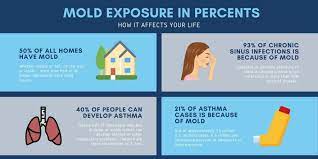Although the term “mold toxicity” is not without its detractors, there is no denying that being around mold may make you sick, and that continuous exposure can cause severe symptoms. Despite the evident link between mold exposure and health problems, many doctors still shy away from using the phrase “mold toxicity” because of the difficulties in precisely identifying the condition.
In this post, we will look at how mold-poisoning symptoms are similar to those of other diseases and ailments. Some people exposed to mold, for instance, report flu-like symptoms and others seem to have seasonal allergies.
Extreme symptoms, such dizziness or stomach troubles, may have their origins in factors unrelated to mold. Similarly, neurological diseases may have other causes following persistent mold exposure.
Toxic mold: what is the deal?
Toxic mold occurs when an individual is exposed to the biotoxins found in mold spores and becomes unwell. What makes it unique is that the symptoms can last indefinitely, even after the person has been removed from exposure to poisonous mold. These symptoms cover a wide spectrum, from those related to the body to those related to the mind and nervous system.
There is continuous dispute regarding whether or not mold poisoning is a legitimate health concern among the medical community. Despite the fact that there is a lot of data supporting its veracity, some experts have argued that it might be a mistake because its symptoms are so similar to those of other disorders. Importantly, mold toxicity results from contact with certain biotoxins that mold spores produce. Many health issues, including death, have been linked to exposure to these chemicals.
Here are 10 Mold-Related Symptoms to Watch Out For
Because of the wide variety of symptoms associated with mold poisoning, a correct diagnosis might be difficult to make without testing. Individual susceptibility, the amount of mold exposure, and the kind of mold all have a role in determining the severity of symptoms. Here are 10 symptoms that might indicate mold poisoning:
Allergic Reactions
Allergic responses are a frequent symptom of mold poisoning. Sneezing, a runny nose, and watery, itchy eyes are all symptoms. These signs and symptoms represent the body’s defence mechanism against irritating substances in the airways.
Long-term exposure to mold can cause nasal and sinus irritation, as well as respiratory issues such chronic sinusitis.
Skin Rashes
Skin rashes can occur after coming into touch with mold or moldy surfaces. Particularly in people with sensitive skin, there is a risk of the skin becoming red, itchy, and irritated. Mold-related skin irritations and rashes are extremely difficult to treat without proper skin care and medical intervention.
Breathing Problems
Breathing problems, such as shortness of breath and wheezing, have been linked to mold poisoning. Inflammation of the airways is a common cause of this, which can be especially worrisome for those with asthma or other respiratory disorders.
Sinus Problems
Congestion of the sinuses from mold exposure can lead to pain and an increased risk of sinus infections and headaches. Understanding the link between mold exposure and headaches is essential for developing effective treatments for these painful conditions.
Muscle and Joint Aches and Pains
Inflammation brought on by mycotoxins can cause aches and pains in the muscles and joints. People who already suffer from one of several prevalent diseases may find this very difficult. Pain in the joints and muscles due to mold poisoning can be managed with a combination of medical treatment and behavioral modifications.
Fatigue
Mold poisoning may be the cause of chronic fatigue and loss of motivation. exposure can trigger an exhausting immunological response in the body, leaving you feeling tired all the time. Mold toxicity should be considered in the examination of anyone who is suffering recurrent lethargy and weakness.
Memory Loss and Confusion
Memory loss and inability to focus are only two of the cognitive effects of mold exposure. “Brain fog” is a common expression for this state of disorientation.
Disorders of Digestion
Mold poisoning can cause gastrointestinal problems in certain people, including nausea, diarrhoea, and abdominal discomfort. Digestive problems and food allergies can be improved by identifying and avoiding mold exposure and making the necessary dietary modifications.
Sensitivity to Light
Photophobia, an abnormal fear of or reaction to bright light, can be a neurological sign of mold poisoning. Light and sound sensitivity can be managed by limiting exposure to mold and using sensory coping strategies.
Metallic taste in Mouth
Mold exposure can cause unpleasant and worrying metallic tastes in the mouth.
Actions to Take for Mold Poisoning
1. Get a Mold Inspection Done by the Experts
Certified mold inspectors should be contacted immediately if any symptoms of mold poisoning are present. Accurate mold inspections of your home may be performed by these experts.
2. Methods of Cleanup and Restoration
Mold may be removed from the environment and prevented from growing again with the use of effective mold removal procedures include physical removal, air cleaning, and mold-resistant coatings.
3. Benefiting the Detoxification Procedure
Helping the liver and kidneys do, their job of detoxification might be beneficial in getting rid of mold toxins. Under medical supervision, detox diets and supplements might be explored.
4. Preventing Mold Growth in Indoor Spaces
Creating a mold-free interior environment requires eliminating water leaks, increasing ventilation, and decreasing humidity.
Bottom Line
Knowing the symptoms of mold poisoning allows people to take preventative measures to safeguard their health. In order to improve health outcomes and provide a safer living environment, it is important to be able to recognise the signs and consequences of mold exposure.
Understanding the dangers of mold and taking precautions against it are two ways to lessen its influence on human health. Avoiding moldy buildings and keeping indoor environments clean and dry can greatly lower the likelihood of developing mold-related health problems.
Note:
Are you a content creator? If yes then we welcome bloggers & they can submit a guest post to our famous blog for free, just search in google, we are on top of search engine “ write for us + home”, You will find “Lifeyet News”.
 Lifeyet News Lifeyet News
Lifeyet News Lifeyet News





